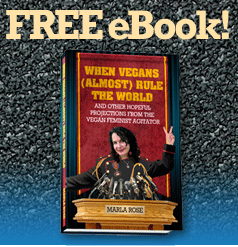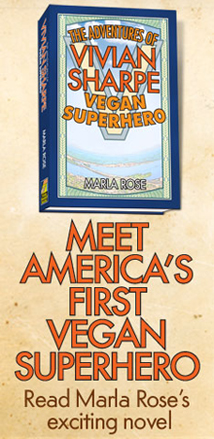
If you would prefer a printed softbound version of When Vegans (Almost) Rule the World, you can pick one up for just $11.99 at Amazon. Kindle eBook coming soon!

Available in either softbound or Kindle/Nook/etc. eBook at Amazon
viviansharpe.com

  Frugally Vegan “I’d think about going vegan but it’s too expensive.” How many times have we heard someone express a sentiment like this or imply that eating vegan is just for the wealthy? Truth be told, it is more expensive to eat fresh, whole foods than to eat off of dollar menus - at least at the outset, because a diet high in animal products can be quite expensive to us down the road in health care - but there are ways to cut that back while not sacrificing an emphasis on unprocessed, natural foods. Here are some simple but effective strategies for cutting back on your food expenses. Grow your own For a few dollars per packet of seeds or a little more for seedlings, you can get exponentially more herbs and produce than you could for the same amount of money at the grocery store. While gardening does have some definite costs involved - like buying soil and other materials - it is also endlessly rewarding. If you don’t have a back yard, look into getting a plot at a community garden. In even a small amount of space, you’d be surprised by how much you can grow. Buy in season Buying in season produce is less expensive than buying out of season, plus it’s more environmentally savvy. Buy locally grown Like buying in season, emphasizing locally grown purchases makes good economic and environmental sense, and it also helps regional growers. When stores don’t need to pay for shipping from far away places, the savings are often passed on to the consumers. Community-Supported Agriculture and U-Pick farms CSAs, in which shareholders receive part of a farm’s yield, can be expensive at first but it is a one-time cost for an abundance of great, often organic, local produce. U-Pick farms are also often a great way to purchase a large volume of local produce for a fraction of it would cost pre-bagged and it’s a lot of fun as well. Canning and preserving What are you going to do with all those bumper crops? Canning and preserving isn’t for everyone but it is highly addictive for those of us who have been bitten by the bug. Canning things like pickles, marinara and salsa from your own garden, as well as making preserves when inexpensive berries are in season, means that you can control the ingredients and the flavors, and you can make a lot for a fraction of the cost of buying at a market. Plus, you get to enjoy the summer’s bounty year-round. Keep in mind, too, that if you have a surfeit of one thing, say zucchini, and your friend has a ton of bell peppers, you could propose a trade of some of hers for yours. Keep a weekly menu and stick to a shopping list This does take a little spontaneity and fun out of your grocery trips, but it can also take a big bite out of your weekly food bill and the amount of time you spend shopping in one fell swoop. This tip offers more bang for the buck than any of the others, in my opinion. Making a weekly menu and shopping list is really not that great a hardship: set aside an hour or so once a week (Sunday is my day), grab a bunch of cookbooks or look at recipe folder you’ve got going on your computer (you do this, right?), sip some tea and get to planning. Planning your meals and sticking to a grocery list means fewer impulse purchases (usually unnecessary conveniences), and as an added benefit, you can look at your diet over the course of a week and make sure it’s balanced. Last, keeping a list is a time management tool as well: not only can you organize your list by where it is at the store, thus have you in and out of the grocery store quicker, but you don’t have to scramble at the last minute to decide what to cook for dinner. Opposite to this, you can find out what produce, grains, etc. are on sale each week at your grocery store and plan your meals around this. Keep a budget If you thought you only had $50 to spend on food, you would probably shop differently than if you thought you had $200. Setting a budget (and sticking to it, which is the hard part) forces you to prioritize your spending and buy more efficiently. Don’t set a really draconian budget (unless you have to). If you scrimp too much, it will will be easier to drop the whole plan. Set a realistic goal that’s a little less than you can afford and stay with it. Sometimes it helps to think of other things you’d rather spend your money on, like new boots or a nice trip, and use that as an incentive to stick to your budget. Click “like” on your favorite products and restaurants Many products and vegan or vegan-friendly restaurants offer exclusive deals to those who “like” them on Facebook. So do some searching on Facebook and get busy! Buy in bulk Find the local grocery stores that allow you to buy in bulk and do it! Grains, beans, baking supplies; all are less expensive without packaging and you can buy the amount you want. Freeze your grains We’ve had issues in the past where we’ve had moths because so many of our grains and flours have come from the bulk bins, which are notorious for being a breeding grounds for moths. When this happens, the items must be tossed out and that’s a waste. By storing items for two or three days in the freezer right after purchasing, you will protect your grains. DIY Doing-it-yourself is the order of the day when it comes to saving money. It only makes sense that things cost more if you have someone else produce it. By making as much as you can on your own, you can keep better quality control over the ingredients as well and make things just to your liking. Things like salad dressings, marinades, breads and more generally cost less if you make them yourself. Of course, making your own meals falls under this heading as well. Make beans from scratch If you’re serious about cutting down on costs and packaging, consider making your own beans from scratch. I use the slow-cooker method (soak the beans overnight, then cook on the high setting with plenty of water, a quartered onion, garlic, a bay leaves). They smell heavenly, taste much better than canned, and a big batch will cost a fraction of what canned beans, already pretty affordable, cost. Extend your meals and your groceries You can get more out of your groceries and cooking by extending your meals. For example, if you make one big pot of veggie chili, that can be served on baked potatoes, on pasta and more throughout the week. Also, make fried rice, savory pancakes, stir-fries, stews, soups, casseroles, veggie burgers and patties, and more with the leftover odds and ends from previous meals. Also, bread that’s past its prime can easily be transformed into croutons, French toast and breadcrumbs. Speaking of soup, make your own freezer stock Ever wonder what to do with the tops of celery, onion skins and carrot peels? Keep the unwanted parts from the produce you use and you will have a virtually free vegetable stock. Instructions here. Keep track of your crisper! Unfortunately, out of sight often means out of mind. Especially during seasons with more abundant produce, maintaining a running account on a dry erase board is a good way to make sure that you’re keeping an essential frugal living mantra alive: waste not, want not. You better shop around Yes, it’s a pain, but if you want to get the best deals, you will have to go where the best deals are found. Here is where you trade time-efficiency for cost-benefits, but many find that going to one store for inexpensive organic produce, your local natural foods store for their weekly specials, ethnic markets for great deals, and a large grocery store for other items pays off. If you have planned your meals ahead of time and have your lists, this will be more efficient and less time-consuming. Mr. Freeze Sometimes you’re so slammed by great deals on in-season produce you couldn’t possibly eat it fast enough and this is when a freezer comes in very handy. In addition to fruits and vegetables, freezing herbs, prepared foods like pesto or cookie dough, and high volume meals works as a money-saving, time-saving strategy. Some people even buy an extra freezer for this purpose. Buy ingredients, not meals Somewhat falling under the same DIY header as above, this is a little different. It means that instead of buying a sandwich, for example, you buy all the sandwich fixings you need and make many more for a fraction of the cost per sammy. Instead of buying pricey, single-serving prepared meals at the grocery store, make your own in a larger quantity for the best savings. Don’t let your cupboard go bare If you have marinara, pasta, olive oil and spices on hand, it is much less tempting to spend more money ordering in or eating out. There are some things that I always have on hand* so I can always make a simple but delicious meal: whole grains (like rice and quinoa), vermicelli noodles, tomato sauce, chickpeas, frozen peas and corn, and some long-lasting produce like onions, garlic, ginger and potatoes. Sounds like the makings of a yummy veggie chili to me! © 2013, 2014, Vegan Street |













 |
 |
 |
 |
 |
 |
 |